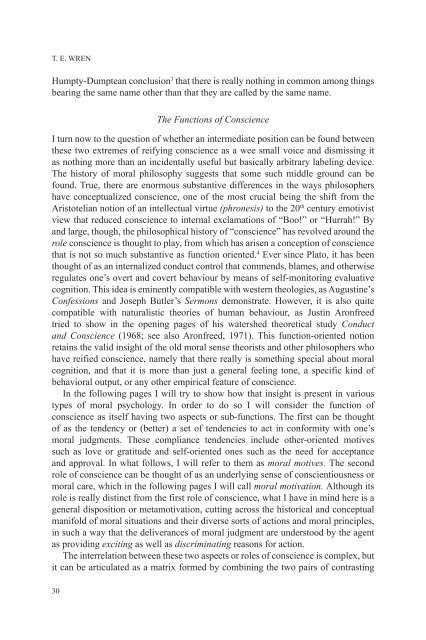Handbook of moral motivation: Theories, models ... - Sense Publishers
Handbook of moral motivation: Theories, models ... - Sense Publishers
Handbook of moral motivation: Theories, models ... - Sense Publishers
- No tags were found...
Create successful ePaper yourself
Turn your PDF publications into a flip-book with our unique Google optimized e-Paper software.
T. E. WRENHumpty-Dumptean conclusion 3 that there is really nothing in common among thingsbearing the same name other than that they are called by the same name.The Functions <strong>of</strong> ConscienceI turn now to the question <strong>of</strong> whether an intermediate position can be found betweenthese two extremes <strong>of</strong> reifying conscience as a wee small voice and dismissing itas nothing more than an incidentally useful but basically arbitrary labeling device.The history <strong>of</strong> <strong>moral</strong> philosophy suggests that some such middle ground can befound. True, there are enormous substantive differences in the ways philosophershave conceptualized conscience, one <strong>of</strong> the most crucial being the shift from theAristotelian notion <strong>of</strong> an intellectual virtue (phronesis) to the 20 th century emotivistview that reduced conscience to internal exclamations <strong>of</strong> “Boo!” or “Hurrah!” Byand large, though, the philosophical history <strong>of</strong> “conscience” has revolved around therole conscience is thought to play, from which has arisen a conception <strong>of</strong> consciencethat is not so much substantive as function oriented. 4 Ever since Plato, it has beenthought <strong>of</strong> as an internalized conduct control that commends, blames, and otherwiseregulates one’s overt and covert behaviour by means <strong>of</strong> self-monitoring evaluativecognition . This idea is eminently compatible with western theologies, as Augustine’sConfessions and Joseph Butler’s Sermons demonstrate. However, it is also quitecompatible with naturalistic theories <strong>of</strong> human behaviour, as Justin Aronfreedtried to show in the opening pages <strong>of</strong> his watershed theoretical study Conductand Conscience (1968; see also Aronfreed, 1971). This function-oriented notionretains the valid insight <strong>of</strong> the old <strong>moral</strong> sense theorists and other philosophers whohave reified conscience, namely that there really is something special about <strong>moral</strong>cognition , and that it is more than just a general feeling tone, a specific kind <strong>of</strong>behavioral output, or any other empirical feature <strong>of</strong> conscience .In the following pages I will try to show how that insight is present in varioustypes <strong>of</strong> <strong>moral</strong> psychology. In order to do so I will consider the function <strong>of</strong>conscience as itself having two aspects or sub-functions. The first can be thought<strong>of</strong> as the tendency or (better) a set <strong>of</strong> tendencies to act in conformity with one’s<strong>moral</strong> judgment s. These compliance tendencies include other-oriented motive ssuch as love or gratitude and self-oriented ones such as the need for acceptanceand approval. In what follows, I will refer to them as <strong>moral</strong> motives. The secondrole <strong>of</strong> conscience can be thought <strong>of</strong> as an underlying sense <strong>of</strong> conscientiousness or<strong>moral</strong> care, which in the following pages I will call <strong>moral</strong> <strong>motivation</strong> . Although itsrole is really distinct from the first role <strong>of</strong> conscience, what I have in mind here is ageneral disposition or meta<strong>motivation</strong>, cutting across the historical and conceptualmanifold <strong>of</strong> <strong>moral</strong> situations and their diverse sorts <strong>of</strong> actions and <strong>moral</strong> principles ,in such a way that the deliverances <strong>of</strong> <strong>moral</strong> judgment are understood by the agentas providing exciting as well as discriminating reasons for action .The interrelation between these two aspects or roles <strong>of</strong> conscience is complex, butit can be articulated as a matrix formed by combining the two pairs <strong>of</strong> contrasting30














